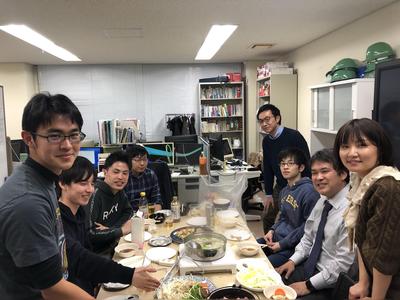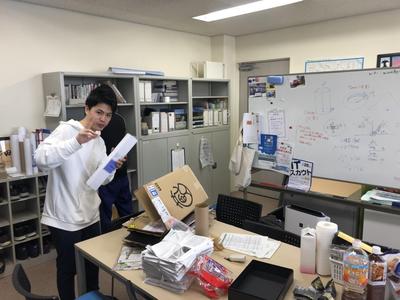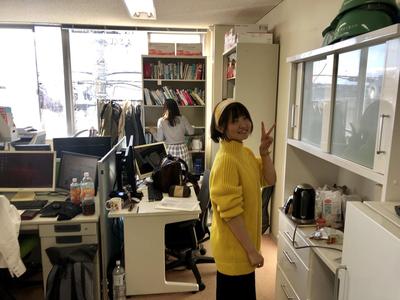Graduation Ceremony and TSU Farewell Party
[2019/03/26]
Here’s the photo section from the recent graduation ceremony, congratulations to our B4s and M2s!
They look dazzling in their gowns and furisode!
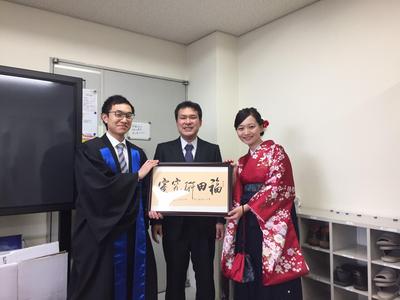
Here are two graduates from the Urban Environmental Studies course!

Next, each course of study was followed by a degree conferment ceremony.
After the graduation ceremony, we held a farewell party for the five TSU laboratories, where the B4 and M2 graduates spoke one by one about their lives at the university and in the laboratory, as well as their aspirations for the future. We hope that you will have many opportunities to interact with us in the future, and we look forward to seeing in the future!
2018 Graduation Ceremony (26th March)
The graduation ceremony for the academic year 2018 was held successfully. Ms. Noriko Kaneko, Mr. Arata Hirabayashi, Mr. Masahiro Imaoka, and Mr. Arata Suzuki graduated from the master course, while Mr. Yusuke Kita graduated from the bachelor course. They all worked hard from morning till night on their research. We wish them further success in their studies. Congratulations! (Fukuda).
Presentation of the graduation dissertation
[2019年2月19日]
Today, the undergraduate graduation thesis presentation of the Department of Civil and Environmental Engineering was held, and Mr. Kita (B4) from our laboratory presented his thesis.
Mr. Kita developed and analyzed a questionnaire survey based on the Stated Preference (SP) method. It was to investigate the intention to use a ride-sharing system with fully-automated vehicles.
The results of the analysis suggested that high preference for new products and general risk aversion tend to influence the intention to use the service, and that a small number of people of the same gender riding in the vehicle is preferred when using the service.
Today, all the undergraduate and master’s thesis submissions and presentations were completed, so we had a launch party after the thesis presentations!
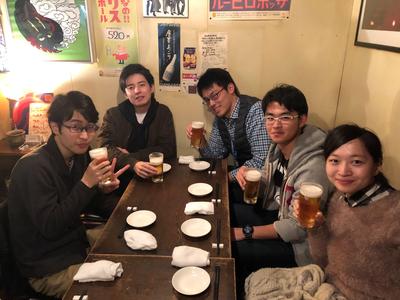
Master’s thesis presentation [Civil Engineering Course]
[2019/02/12]
Today, the master’s thesis presentation of the Civil Engineering course was held. (M2 students) Mr. Suzuki and Mr. Imaoka from our laboratory gave their presentations. All the presentations and Q&A sessions were conducted in English, and thanks to their hard practice, everyone presented in fluent English. Thank you very much for your presentation!
In addition, there were many questions from professors from other fields other than civil engineering, and there was a lively discussion during today’s presentations. Thanks to all the professors who asked questions.

Master’s thesis presentation [Urban and Environmental Studies Course]
[2019年2月5日]
Today, the master’s thesis presentation of the Urban and Environmental Studies course was held. (M2 students) Ms. Kaneko and Mr. Hirabayashi from our laboratory gave their presentations.
Unlike presentations in civil engineering and urban planning, students from various fields made presentations here. Hence, they focused on conveying difficult research content in an easy-to-understand manner for people from other fields. As a result of continuing to practice presentations and preparing materials until late every day, they were able to make a highly complete presentation. Thanks for their hard practices!
Moreover, thanks to all the teachers who asked questions.
PS: Ms. Kaneko won the second place overall in the voting for the best presentation held after the presentation. It was very close to the 1st place, but it is wonderful. Congratulations! (Fukuda)
Master’s Thesis Submission Part 2
[2019/01/31]
Today, Mr. Hirabayashi and Ms. Kaneko, M2 students in the Urban and Environmental Studies course, have have completed the main body of their master’s thesis.
Mr. Hirabayashi’s thesis, entitled “Extraction of Distribution Patterns of Speed-Density Relationship of Pedestrian Flow Considering Spatial Correlation,” is aimed at establishing a precise pedestrian space evaluation index necessary for ensuring safety and comfort in walking spaces, using detailed pedestrian movement trajectory data and a method to extract spatial patterns that enables understanding of local spatiality. The establishment of this method was carried out.
Ms. Kaneko, in her thesis entitled “Research on Sequential Route Selection Model and Optimal Congestion Charging,” developed a framework for optimal congestion charging under Markovian Traffic Equilibrium (MTE), which is an equilibrium allocation based on a Markov process in which travelers select routes sequentially, and implemented it on a large-scale network.
Master’s Thesis Submission Part 1
[2019/01/25].
Today, Mr. Imaoka and Mr. Suzuki, M2 students in the Civil Engineering course, have completed the main body of their master’s thesis.
Mr. Imaoka’s research question is whether the Fundamental Diagram, which is often used for automobile traffic flow, can be applied to the actual operation of urban trains that operate at high frequency. He has verified the reproducibility of the current situation using observed data, but the model does not fit the actual situation well, and he is struggling to find out which point is the cause of the problem.
Mr. Suzuki has optimized an intercity transportation network that takes into account passenger excursion behavior in 9 cities across Japan, and has confirmed that the shape of the network changes significantly compared to the shape without the inclusion of excursion behavior.
We are now approaching the submission and presentation of the abstracts, so please work hard in your last spurt.
2nd Hotpot Party
[2018/01/10]
Happy New Year … Today we had our second ‘nabe’ (hotpot) party, which we call a New Year’s party! It’s been cold lately, so let’s warm up with the ‘nabe’!
Lab cleaning & Lab year-end party
[2018/12/28]
Our laboratory has been lightly cleaning after each seminar, but today we called it a ‘big’ lab cleaning and thoroughly cleaned the areas that are not usually cleaned, such as tidying and dusting the bookshelves, wiping windows and blinds. Let us keep the Japanese tradition of cleaning at the end of the year to welcome the New Year.
We had a wonderful time at the lab’s year-end party, where our alumni, including Dr. Yanaginuma, a lecturer at Tokyo University of Science, and Prof. Fukuda’s family members, came to the party.
 Many people also came to the 2nd round party. Let’s make sure we have another fun day like this next year, so that we can all live a fulfilling life!
Many people also came to the 2nd round party. Let’s make sure we have another fun day like this next year, so that we can all live a fulfilling life!

2018 TSU midterm presentation
[2018/12/27]
The annual midterm presentation of the five laboratories of the Tokyo Tech Transport Studies Unit (TSU) was jointly held on campus. The TSU year-end party was held after the presentations by B4 and M2 students and critiques by their professors. The professors told the students to make their research presentations interesting, and I personally agreed with their advice.
From our laboratory, (B4 student) Mr. Kita, (M2 students) Ms. Hirabayashi, Mr. Imaoka, Ms. Kaneko, and Mr. Suzuki presented their research. M1 students also participated in the lecture and received some good inspiration. There are less than two months left until the presentation of the thesis and dissertation, so please take care of yourself and do your best in your last spurt!









